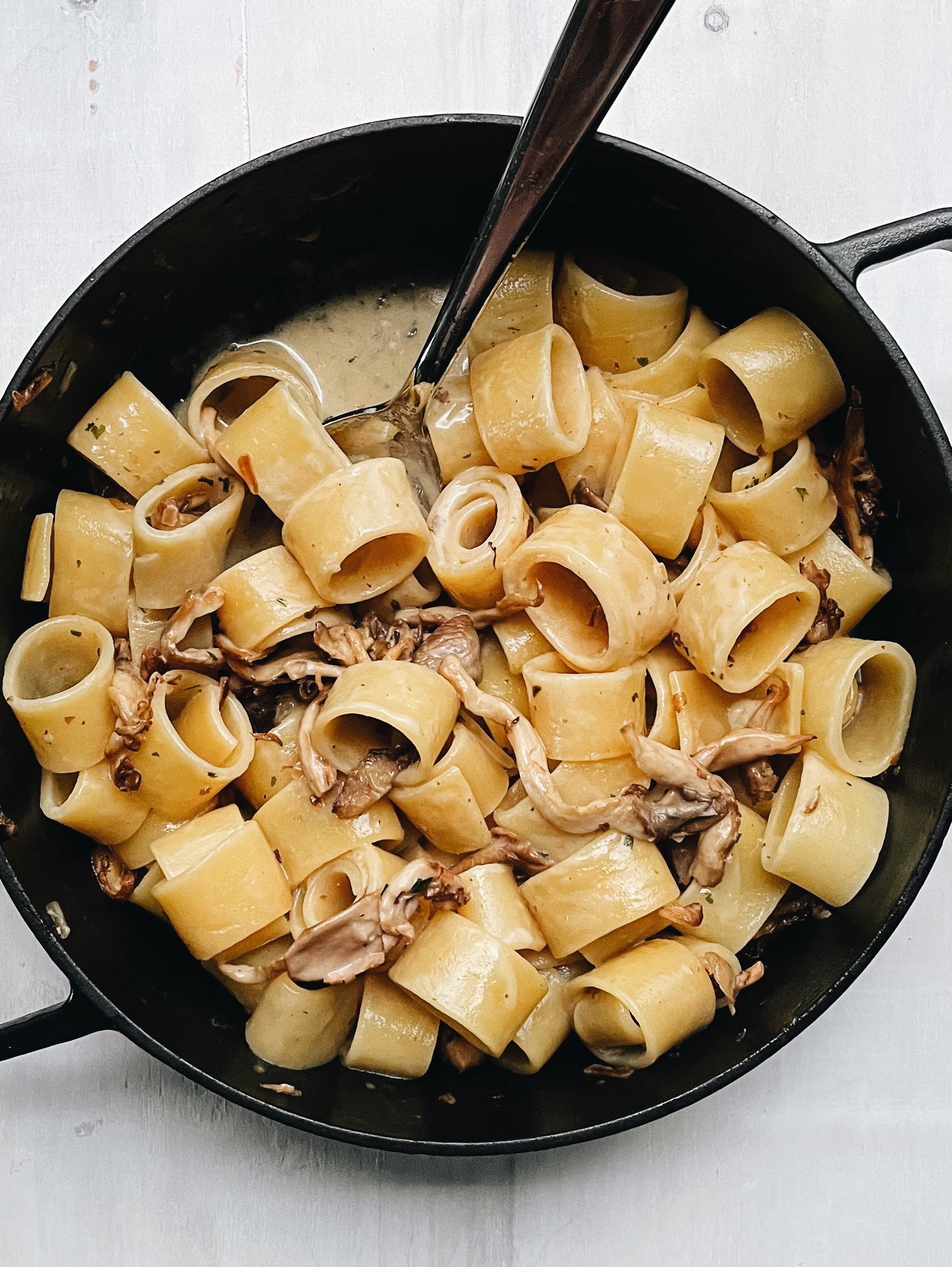simple summery shroom pasta
While “mushroom season” is a long one, whatever it is is definitively not now (it’s summer). However, every week at the farmer’s market is a shroom stand full of little paper boxes of mushrooms harvested that morning, that come with care instructions so specific it feels as if you’ve just adopted a living pet. After coming home from a week on the road, my boyfriend surprised me with these mushrooms, left over from his week’s cooking, and asked me what I wanted to do with them. This is how we add yet another Simple Summer Pasta to the SSP collection: a shroomy rendition that feels maybe a little more September than August, but in the very best way.
The trick to making a good simple shroomy pasta is, as it turns out, dry-sautéing your mushrooms. This was a tip from the mushroom stand person at the farmer’s market, and it’s a good one: you just throw torn up mushrooms, which gives them nice craggly edges, into a pan over medium-high heat with absolutely nothing else. I’ll spare you the complexities of the science behind this, but basically, mushrooms are little sponges that tend to absorb the cooking fat before they’re dry enough to get nicely browned in that fat; adding salt too early makes them retain water instead of losing it, which slows this process down even further. Cooking them this way allows the mushrooms to release their water first, so they can then crisp up when you add fat and actually take on seasoning with salt.
The other trick, not an unfamiliar one if you’ve made any of my other pasta dishes, has to do with undercooking your pasta. While it’s usually customary to toss pasta in any sauce before you serve, here we are deliberately undershooting our cook time; the pasta will be not al dente, but actually crunchy by the time you move it over into the pan. Because this is a very light, delicate sauce, we want that flavor to fully penetrate (yes) the pasta. In order for the cooking to continue in the sauce, though, we need a lot more pasta water than if you were just finishing the dish. I’ve referred to it in the past as the “risotto method,” but all it really means is that you’re swapping the last few minutes of plain old boiling water absorption with something more flavorful.
recipe
A summer-to-fall transition pasta featuring dry-sauteed oyster mushrooms, shallots, a splash of cream, and lots of parm.
Effortful time: 10 minutes
Total time: 20 minutes
Serves 2
you need
12 oz. oyster mushrooms, torn into bite-sized pieces
2 tbsp. olive oil
1 tbsp. butter
1 small shallot, minced
Kosher salt
1/4 cup heavy cream
1/4 cup grated parm, plus more for serving
8 oz. thick-cut pasta; this is calamarata, but rigatoni, paccheri, or even pappardelle will also work
make it
Boil water for pasta. Salt it, obviously.
Dry-sauté the mushrooms. When your water is at a simmer, heat a deep skillet to medium-high heat. Add your torn mushrooms to the pan without any fat or salt, and let them just… sit there til they start to crisp around the edges, moving them around every so often with tongs or a spoon.
Cook your pasta. Right around the time your mushrooms are looking good, add your pasta. Cook this for 2 minutes under the lower number on the package directions. In the meantime, you’ll make your shroom sauce.
Finish the shrooms. Once the mushrooms are looking dried out and have frizzled edges, drizzle in your olive oil and throw in your pat of butter, and give them a good salt. Sauté about 3-4 minutes, or until the mushrooms are properly crisping. Then add the shallot, and sauté 1 minute longer. At this point the shallot should be soft and the shrooms should be nicely browned.
Create the sauce. Add the cream and gently simmer until bubbling and thickened, about 2 minutes. Season. Keep over your lowest possible heat.
Finish and serve. Use a slotted spoon to transfer the pasta to the mushroom pan. Add a generous ladleful of pasta water; this will help the pasta finish cooking. It will look soupy until the pasta starts absorbing the liquid; as you reach al dente, add more water if it looks dry. Shower with fresh parm and serve.



